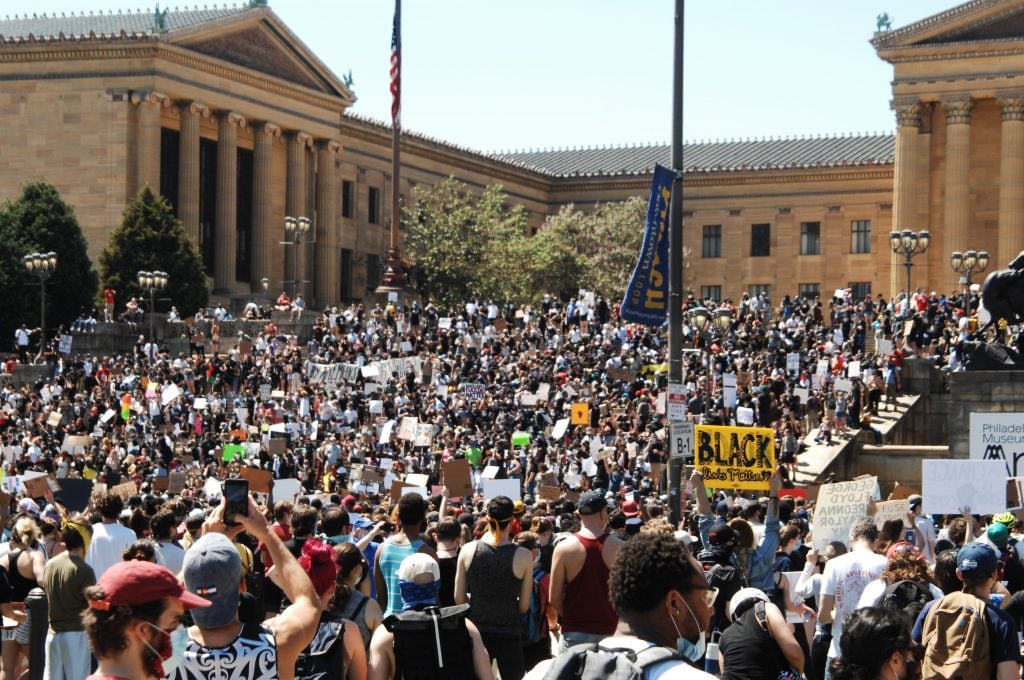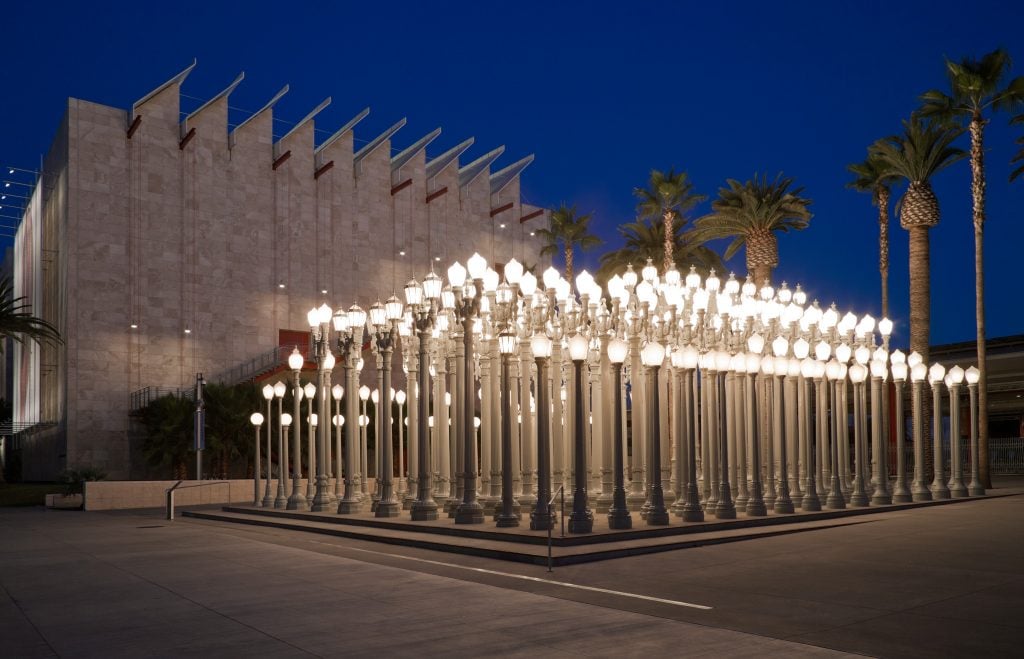Art World
The George Floyd Protests Spurred Museums to Promise Change. Here’s What They’ve Actually Done So Far
Which institutions are following through on their commitments and which are dragging their feet?

Which institutions are following through on their commitments and which are dragging their feet?

Taylor Dafoe &
Caroline Goldstein

In the wake of George Floyd’s murder and the subsequent protests, museums across the country began making pledges to initiate change within their walls. In emails and social media posts, institutions impugned racism and acknowledged their own complacency in systems that perpetuate it. They preached solidarity and inclusivity. They vowed to take a good hard look in the mirror, to reject silence, and to listen and learn.
Important though those statements were, many wanted even more to see action. Some institutions offered concrete plans, including, for example, staff trainings, inclusivity committees, and more diverse programming goals. But many also appeared content to rely on platitudes, or only delivered tangible plans after being called out for their passivity.
Below, we’ve collected various institutional pledges and checked in with them to see what progress they’ve made so far.
In late June, an open letter penned by six former employees of the New Orleans Museum of Art accused the institution of propagating “a plantation-like culture behind its facade” and for having a homogenous, mostly white staff. The letter, which began with the words “DISMANTLE NOMA,” cited a permanent installation called “The Greenwood Parlor” as an example of the museum’s insensitivity to racism. In response to the letter and public outcry, the museum posted a statement with both short- and long-term goals.
Where things stand: The museum has brought on an organization to facilitate diversity and equity training with staff that began this month and launched new systems for visitors to share questions and feedback. The institution is currently reaching out to community stakeholders and partners for “broader input on ‘The Greenwood Parlor,’” and implementing a new process for employees and individuals in the community to provide input on museum projects through an external group of advisors.

Installation view of Julie Mehretu’s HOWL eon (I, II) (2017) at SFMOMA. Photo: Matthew Millman Photography.
Former employee Taylor Brandon accused the museum of deleting a critical comment she made on an Instagram post that pictured the artwork of Glenn Ligon. In her comment, Brandon called out the museum for not supporting Black employees and mentioned specific names of upper managers, which SFMOMA claims violated Instagram’s terms of service. After a public outcry, the museum re-enabled posts to the original image and apologized. Following the incident, Nan Keeton, deputy director for external relations, left the museum, as did the recruitment staffing manager, and the director of human resources.
A month later, senior curator Gary Garrels resigned from his position after a former employee complained on social media that Garrels had said that, despite a recent push toward collecting work by artists of color, SFMOMA would continue to acquire works by white men, because not doing so would amount to reverse discrimination. Former employees created a petition calling for his resignation, and Garrels stepped down shortly thereafter.
Where things stand: The museum is currently interviewing candidates for the two director positions and, this week, is speaking with consultants to oversee anti-racist and implicit bias training for staff. Administration has begun investigating complaints of discrimination and harassment, past and present, and is in the process of revising its exhibition review system. The staff’s administrative bathrooms are now gender neutral. Two paid interns from historically Black colleges and universities are working remotely with the curatorial team this summer.
When the Met’s new director, Max Hollein, sent a letter declaring the museum’s commitment to diversity and support of Black Lives Matter, it was accompanied by a reproduction of Glenn Ligon’s artwork Untitled (I Do Not Always Feel Colored). In an Instagram post, Ligon called out the museum for not asking his permission to use the work, writing, “could y’all just stop, or ask me first?” Hollein apologized personally to the artist.
The Met’s chairman of European paintings, Keith Christiansen, was also the subject of public criticism after he posted an image of a French archaeologist on Juneteenth with a caption decrying “revolutionary zealots” who tore down monuments during the French Revolution. The underlying message—that contemporary protesters dismantling monuments to racist historical figures are comparable zealots—prompted outcry from staff and the public. In response to internal demands, the museum issued an institution-wide 13-prong anti-racism and diversity plan, including a $3 million fund to support the effort.
Where things stand: The Met has completed anti-racism training for department heads. Thanks to a recent gift from Adrienne Arsht, all Met internships will also now be paid. According to a spokesperson, “many other activities are in progress as reflected in our Commitments.”
In late June, 70 former staff members at MOCAD wrote a letter to the board calling for the removal of chief curator and executive director Elysia Borowy-Reeder, citing multiple instances of racist behavior. The writers of the letter, who chose to remain anonymous, claim that they had seen Borowy-Reeder commit “various racist micro-aggressions, mis-gendering, violent verbal outbursts, and the tokenization of marginalized artists, teen council members, and staff.”
The letter followed the departure of three Black curators from the museum in the previous eight months. Borowy-Reeder was suspended by the board before being fired outright on July 29. “We have no tolerance for harassment, discrimination, or abuse in any form,” the museum’s board wrote in a letter following the move.
Where things stand: Elyse Foltyn, the chair of MOCAD’s board, said in a statement to Artnet News that the museum has established a special review committee to propose ways to enhance diversity, equity, and inclusion efforts. It is “pursuing immediate and necessary actions to increase the diversity of the nominating committee, executive committee, and board,” and “assessing how the employee voice can best be heard by the board.” The institution is also in the process of updating the MOCAD bylaws to revisit all protocols, including those that say employees can render complaints “related to the museum and its management.” It is also amending its employee handbook and benefits to assure employees are treated equitably. The museum has recently begun offering its employees parental leave.

Screenshot of American Artist’s project for the Whitney, titled Looted. Courtesy of the Whitney Museum.
The Whitney is no stranger to controversy. In 2017, a firestorm of criticism ensnared its biennial for its inclusion of Dana Schutz’s painting of lynched teenager Emmett Till in his coffin. At the next biennial, in 2019, protesters and participating artists boycotted the show in opposition to board member Warren Kanders, who owns Safariland, a producer of tear gas. (He eventually resigned.) Then, when the George Floyd protests engulfed New York streets, the Whitney boarded up its High Line-adjacent building, at a time when other local museums were offering their lobbies to aid protesters.
To celebrate Juneteenth, assistant curator Rujeko Hockley partnered with Instagram for a virtual exhibition celebrating Black artists, telling The Cut, “Art and protest, both, help us do this ‘freedom dreaming.’” In late July, the museum commissioned American Artist to create a digital work, part of an ongoing series titled “Looted,” which virtually “boarded up” the very artworks posted online.
Where things stand: “A process is underway to develop a plan that looks at all areas of our work (staff, program, audience/community, and patrons/board),” a representative for the museum told Artnet News. “The plan will highlight important steps already taken over the past few years and set a path forward for the institution to achieve the goals outlined by [director] Adam Weinberg in his letter. Over the next 14 months we will debut 10 exhibitions largely devoted to the work of BIPOC artists. In addition, we’ve made progress in working to identify and engage the best partners to facilitate anti-racism and unconscious bias training sessions for 100 percent of our staff, which we expect will begin by early fall.”
After the museum posted a vague message on social media stating its support for “equity and fairness,” followers quickly sounded off on the lack of a more meaningful statement that explicitly mentioned George Floyd or Black Lives Matter. In the wake of the criticism, Getty CEO James Cuno issued an apology that expressed remorse for its previously bland words, and promised a more responsible stance in the future. An open letter to the Getty’s board addressed the systemic racism and underlying inequities that exist within the institution, describing the newly created DEI council and task forces as lacking funding or support. Signatories also noted the overwhelming majority of white people holding senior positions and asked that the Getty ensure its own community adheres to the values it claims to espouse.
Where things stand: The institution had no updates on progress made, noting that the “Getty board of trustees meets in mid-September” and they “anticipate having something to share around that time.”

Chris Burden, Urban Light (2008), at the Los Angeles County Museum of Art. Photo photo by Museum Associates/LACMA, ©Chris Burden/licensed by the Chris Burden Estate and Artists Rights Society (ARS), New York.
LACMA was one of the few institutions that participated in the #blackouttuesday social media initiative on its website, and went dark for a week to show solidarity with Black Lives Matter. The message was posted on Unframed, LACMA’s blog, and echoed broad sentiments opposing historical injustices and standing against violence.
Where things stand: “For LACMA, there is a renewed urgency to our efforts to move quickly to diversify the collection—and to make those efforts visible,” a representative from the museum told Artnet News. The institution has held two programs in its ongoing “Racism is a Public Health Issue” series so far: “Addressing Prejudices Against Asian Americans During the COVID-19 Pandemic” on May 7 and “Examining the Impact of Police Brutality on Black Communities in the Age of COVID-19” on July 21. The next program is set for September. The institution is planning a year-long series of programs showcasing recent acquisitions, with a “majority of the works shown created by BIPOC artists.” The programs will be accompanied by “discussions among curators and guest speakers,” the representative added. “The Black Lives Matter movement and efforts to end structural racism are sure to be recurring themes.”
In June, 22 members of the Guggenheim’s 23-person curatorial team sent a letter to the institution’s leadership demanding action in addressing what they called an “inequitable work environment that enables racism, white supremacy, and other discriminatory practices.” They also asked leaders to apologize to Chaédria LaBouvier, who in 2019 became the first Black curator to organize a solo show at the Guggenheim. “Working at the Guggenheim w/ Nancy Spector & the leadership was the most racist professional experience of my life,” LaBouvier wrote on Twitter. (Spector is currently taking a three-month sabbatical.) The curator’s letter goes on to castigate the museum for failing to “respond adequately—whether through statements or programming—to the global protests triggered by the murder of George Floyd.”
“We recognize the importance of developing inclusive programming, deepening community engagement, and diversifying our collection and exhibitions, staff, and board of trustees,” the museum’s director Richard Armstrong said in a statement on June 9—two weeks after Floyd’s murder. Armstrong pledged to create “paths that lead to a more inclusive and diverse museum and workplace,” but was otherwise largely devoid of concrete goals. Since then, the museum has made its full Diversity, Equity, Access and Inclusion (DEAI) plan publically available.
Where things stand: The museum has established a DEAI committee and created and shared its DEAI plan with the public.
“We are proud of the progress we’ve made while acknowledging that we have much work to do,” Armstrong said in a statement to Artnet. “The board of trustees has expressed their support of and commitment to working together with me and our staff to realize the plan.
Editor’s note: This article was updated August 17 to reflect the Guggenheim’s new DEAI plan.